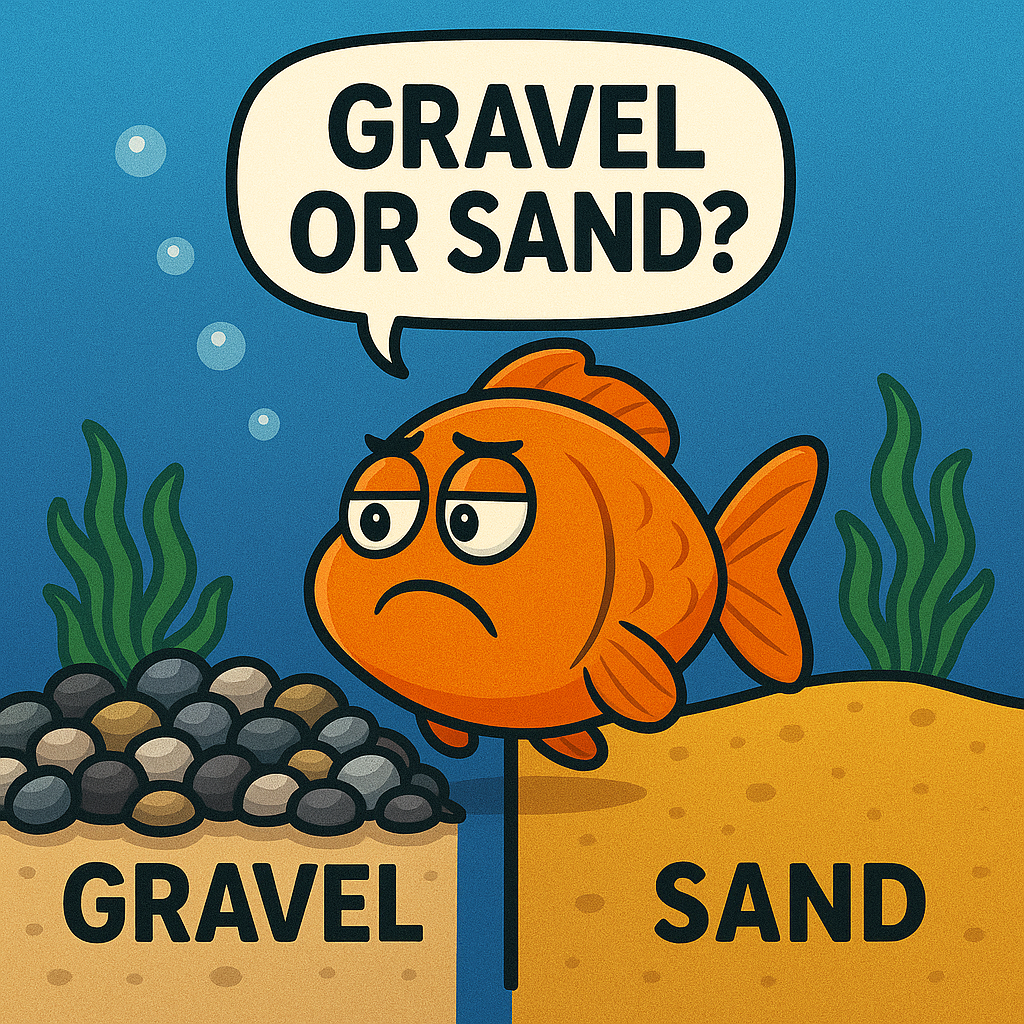🐠 Choosing the Best Substrate for Your Aquarium
🐟 For Bottom-Dwelling & Digging Fish
- 🌊 Sand
- ✅ Best for Corydoras, loaches, plecos, and other bottom-feeders
- ✅ Smooth grains prevent cuts on sensitive barbels and fins
- ✅ Allows natural digging and sifting behaviors
- ✅ Easy to clean since waste sits on top (doesn’t fall between gaps)
- ⚠️ Needs regular stirring or bottom-feeders to prevent gas pockets
🐠 For African Cichlids
- 🪨 Aragonite Sand or Crushed Coral
- ✅ Buffers water, maintaining higher pH and hardness (7.8–8.6)
- ✅ Mimics natural habitats of Rift Lake cichlids
- ✅ Encourages digging without risk of injury
- ⚠️ Not suitable for soft-water fish (tetras, discus, etc.)
🌿 For Planted Aquariums
- 🌱 Nutrient-Rich Substrate (e.g., Fluval Stratum, Eco-Complete, ADA Aqua Soil)
- ✅ Feeds roots directly for strong plant growth
- ✅ Looks natural and enhances aquascapes
- ✅ Can be combined with sand/gravel top layers for aesthetics
- ⚠️ More expensive than plain sand or gravel
- ⚠️ Needs careful vacuuming (can be disturbed easily)
🐡 For Large Catfish, Plecos, & River Fish
- 🏞️ Rounded Gravel or Sand
- ✅ Safer than sharp gravel, avoids fin/skin injuries
- ✅ Mimics riverbeds, plecos can forage naturally
- ✅ Provides hiding spaces for microfauna (good supplemental food)
- ⚠️ Gravel traps waste → requires siphoning more thoroughly
🐠 For Community Tanks (Tetras, Guppies, Barbs, Bettas, etc.)
- 💎 Fine Gravel or Sand
- ✅ Versatile — works for most species
- ✅ Compatible with plants and decorations
- ✅ Available in many colors and grain sizes
- ⚠️ Large gravel can trap debris
- ⚠️ Sand can compact without cleaners or burrowers
🪣 Bare-Bottom Tanks
- 🧽 No Substrate (Glass or Acrylic Bottom)
- ✅ Super easy to clean (ideal for fry tanks, breeding, or hospitals)
- ✅ No risk of anaerobic buildup or waste hiding
- ✅ Good for heavy feeding or sensitive fish setups
- 🚫 Doesn’t look natural (aesthetic downside)
- 🚫 Fish that like digging/foraging may become stressed
❌ What to Avoid
- ⚠️ Sharp gravel/pebbles → cuts barbels, fins, and bellies of bottom-dwellers
- ⚠️ Painted gravel that flakes → toxic to fish
- ⚠️ Deep, unturned sand beds → can create dangerous hydrogen sulfide gas pockets
📝 Quick Comparison Chart
| Substrate | Best For | Pros ✅ | Cons ❌ |
|---|---|---|---|
| 🌊 Sand | Corydoras, loaches, plecos, cichlids | Natural, safe for bottom-dwellers, waste stays on top | Needs stirring, can compact |
| 🪨 Aragonite / Crushed Coral | African cichlids | Buffers pH/hardness, good for digging | Not for soft-water fish |
| 🌱 Planted Substrate | Heavily planted aquariums | Feeds plants, natural look | Expensive, tricky cleaning |
| 🏞️ Rounded Gravel | Plecos, catfish, river setups | Safe, natural, stable base | Traps waste, needs siphoning |
| 💎 Fine Gravel | Community tanks | Easy to clean, versatile | Large gravel traps debris |
| 🧽 Bare-Bottom | Breeding, fry, hospital tanks | Easiest to clean, hygienic | No digging, less natural look |
👉 If you tell me which specific fish species you keep, I can narrow this down to the #1 best substrate choice for your setup. Would you like me to tailor the recommendation to your fish?
